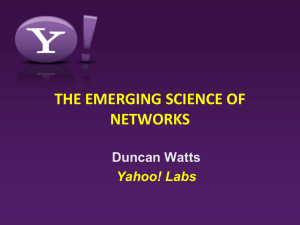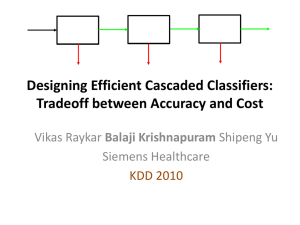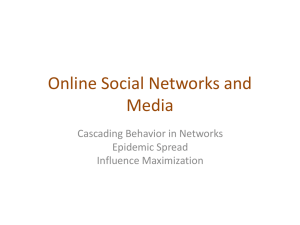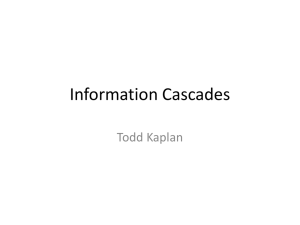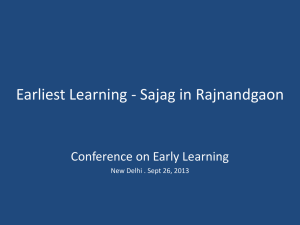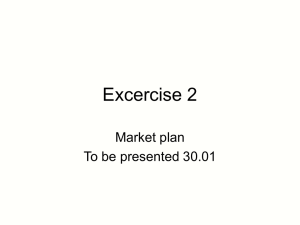L14-lecture8a
advertisement
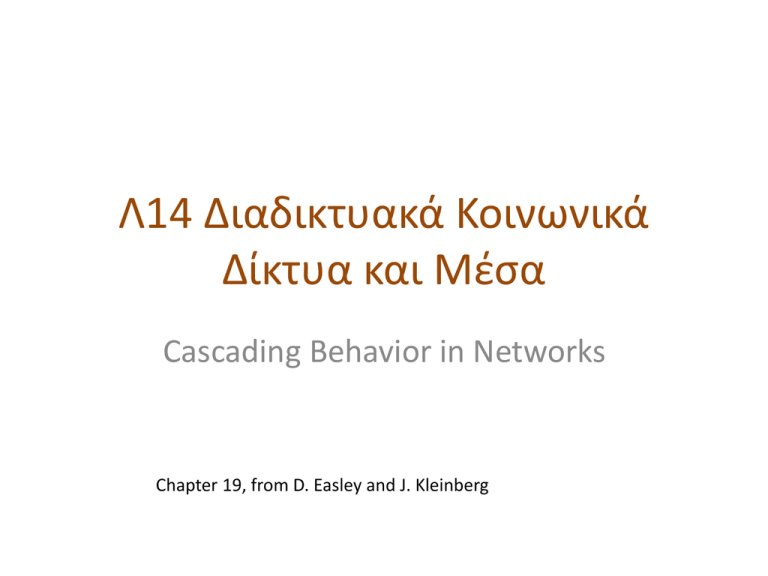
Λ14 Διαδικτυακά Κοινωνικά Δίκτυα και Μέσα Cascading Behavior in Networks Chapter 19, from D. Easley and J. Kleinberg Diffusion in Networks How new behaviors, practices, opinions and technologies spread from person to person through a social network as people influence their friends to adopt new ideas Information effect: choices made by others can provide indirect information about what they know Old studies: Adoption of hybrid seed corn among farmers in Iowa Adoption of tetracycline by physicians in US Basic observations: Characteristics of early adopters Decisions made in the context of social structure Diffusion in Networks Direct-benefit Effect: there are direct payoffs from copying the decisions of others Spread of technologies such as the phone, email, etc Common principles: Complexity of people to understand and implement Observability, so that people can become aware that others are using it Trialability, so that people can mitigate its risks by adopting it gradually and incrementally Compatibility with the social system that is entering (homophily?) Modeling Diffusion through a Network An individual level model of direct-benefit effects in networks due to S. Morris The benefits of adopting a new behavior increase as more and more of the social network neighbors adopt it A Coordination Game Two players (nodes), u and w linked by an edge Two possible behaviors (strategies): A and B If both u and w adapt A, get payoff a > 0 If both u and w adapt B, get payoff b > 0 If opposite behaviors, than each get a payoff 0 Modeling Diffusion through a Network u plays a copy of the game with each of its neighbors, its payoff is the sum of the payoffs in the games played on each edge Say some of its neighbors adopt A and some B, what should u do to maximize its payoff? Threshold q = b/(a+b) for preferring A (at least q of the neighbors follow A) Modeling Diffusion through a Network: Cascading Behavior Two obvious equlibria, which ones? Suppose that initially everyone is using B as a default behavior A small set of “initial adopters” decide to use A When will this result in everyone eventually switching to A? If this does not happen, what causes the spread of A to stop? Observation: strictly progressive sequence of switches from A to B Modeling Diffusion through a Network: Cascading Behavior a = 3, b = 2, q = 2/5 Step 1 Chain reaction Step 2 Modeling Diffusion through a Network: Cascading a = 3, b = 2, q = 2/5 Behavior Step 3 Modeling Diffusion through a Network: Cascading Behavior Chain reaction of switches to A -> a cascade of adoptions of A 1. Consider a set of initial adopters who start with a new behavior A, while every other node starts with behavior B. 2. Nodes then repeatedly evaluate the decision to switch from B to A using a threshold of q. 3. If the resulting cascade of adoptions of A eventually causes every node to switch from B to A, then we say that the set of initial adopters causes a complete cascade at threshold q. Modeling Diffusion through a Network: Cascading Behavior and “Viral Marketing” Tightly-knit communities in the network can work to hinder the spread of an innovation (examples, age groups and life-styles in social networking sites, Mac users, political opinions) Strategies Improve the quality of A (increase the payoff a) Convince a small number of key people to switch to A Cascades and Clusters A cluster of density p is a set of nodes such that each node in the set has at least a p fraction of its neighbors in the set Ok, but it does not imply that any two nodes in the same cluster necessarily have much in common The union of any two cluster of density p is also a cluster of density p Cascades and Clusters Cascades and Clusters Claim: Consider a set of initial adopters of behavior A, with a threshold of q for nodes in the remaining network to adopt behavior A. (i) (clusters as obstacles to cascades) If the remaining network contains a cluster of density greater than 1 − q, then the set of initial adopters will not cause a complete cascade. (ii) (clusters are the only obstacles to cascades) Whenever a set of initial adopters does not cause a complete cascade with threshold q, the remaining network must contain a cluster of density greater than 1 − q. Cascades and Clusters Proof of (i) (clusters as obstacles to cascades) Proof by contradiction Let v be the first node in the cluster that adopts A Cascades and Clusters Proof of (ii) (clusters are the only obstacles to cascades) Let S be the set of nodes using B at the end of the process Show that S is a cluster of density > 1 - q Diffusion, Thresholds and the Role of Weak Ties A crucial difference between learning a new idea and actually deciding to accept it Diffusion, Thresholds and the Role of Weak Ties Relation to weak ties and local bridges q = 1/2 Bridges convey awareness but weak at transmitting costly to adopt behaviors Extensions of the Basic Cascade Model: Heterogeneous Thresholds Each person values behaviors A and B differently: If both u and w adapt A, u gets a payoff au > 0 and w a payoff aw > 0 If both u and w adapt B, u gets a payoff bu > 0 and w a payoff bw > 0 If opposite behaviors, than each gets a payoff 0 Each node u has its own personal threshold qu≥ bu /(au+ bu) Extensions of the Basic Cascade Model: Heterogeneous Thresholds Not just the power of influential people, but also the extent to which they have access to easily influenceable people What about the role of clusters? A blocking cluster in the network is a set of nodes for which each node u has more that 1 – qu fraction of its friends also in the set. Knowledge, Thresholds and Collective Action: Collective Action and Pluralistic Ignorance A collective action problem: an activity produces benefits only if enough people participate Pluralistic ignorance: a situation in which people have wildly erroneous estimates about the prevalence of certain opinions in the population at large Knowledge, Thresholds and Collective Action: A model for the effect of knowledge on collective actions Each person has a personal threshold which encodes her willingness to participate A threshold of k means that she will participate if at least k people in total (including herself) will participate Each person in the network knows the thresholds of her neighbors in the network w will never join, since there are only 3 people v u Is it safe for u to join? Is it safe for u to join? (common knowledge) Knowledge, Thresholds and Collective Action: Common Knowledge and Social Institutions Not just transmit a message, but also make the listeners or readers aware that many others have gotten the message as well Social networks do not simply allow or interaction and flow of information, but these processes in turn allow individuals to base decisions on what other knows and on how they expect others to behave as a result The Cascade Capacity Given a network, what is the largest threshold at which any “small” set of initial adopters can cause a complete cascade? Cascade capacity of the network Infinite network in which each node has a finite number of neighbors Small means finite set of nodes The Cascade Capacity: Cascades on Infinite Networks Initially, a finite set S of nodes has behavior A and all others adopt B Time runs forwards in steps, t = 1, 2, 3, … In each step t, each node other than those in S uses the decision rule with threshold q to decide whether to adopt behavior A or B The set S causes a complete cascade if, starting from S as the early adopters of A, every node in the network eventually switched permanently to A. The cascade capacity of the network is the largest value of the threshold q for which some finite set of early adopters can cause a complete cascade. The Cascade Capacity: Cascades on Infinite Networks An infinite path Spreads if ≤ 1/2 An infinite grid Spreads if ≤ 3/8 An intrinsic property of the network Even if A better, for q strictly between 3/8 and ½, A cannot win The Cascade Capacity: Cascades on Infinite Networks How large can a cascade capacity be? At least 1/2, but is there any network with a higher cascade capacity? Will mean that an inferior technology can displace a superior one, even when the inferior technology starts at only a small set of initial adopters. The Cascade Capacity: Cascades on Infinite Networks Claim: There is no network in which the cascade capacity exceeds 1/2 The Cascade Capacity: Cascades on Infinite Networks Interface: the set of A-B edges Prove that in each step the size of the interface strictly decreases Why is this enough? The Cascade Capacity: Cascades on Infinite Networks At some step, a number of nodes decide to switch from B to A General Remark: In this simple model, a worse technology cannot displace a better and wide-spread one Compatibility and its Role in Cascades An extension where a single individual can sometimes choose a combination of two available behaviors Coordination game with a bilingual option Two bilingual nodes can interact using the better of the two behaviors A bilingual and a monolingual node can only interact using the behavior of the monolingual node Is there a dominant strategy? Cost c associated with the AB strategy Compatibility and its Role in Cascades Example (a = 2, b =3, c =1) B: 0+b = 3 A: 0+a = 2 AB: b+a-c = 4 √ B: b+b = 6 √ A: 0+b = 3 AB: b+b-c = 5 Compatibility and its Role in Cascades Example (a = 5, b =3, c =1) B: 0+b = 3 A: 0+a = 5 AB: b+a-c = 7 √ Compatibility and its Role in Cascades Example (a = 2, b =3, c =1) First, strategy AB spreads, then behind it, node switch permanently from AB to A Strategy B becomes vestigial Compatibility and its Role in Cascades Given an infinite graph, for which payoff values of a, b and c, is it possible for a finite set of nodes to cause a complete cascade of adoptions of A? Fixing b = 1 Given an infinite graph, for which payoff values of a (how much better the new behavior A) and c (how compatible should it be with B), is it possible for a finite set of nodes to cause a complete cascade of adoptions of A? A does better when it has a higher payoff, but in general it has a particularly hard time cascading when the level of compatibility is “intermediate” – when the value of c is neither too high nor too low Compatibility and its Role in Cascades Example: Infinite path Spreads when q ≤ 1/2, a ≥ b (a better technology always spreads) Assume that the set of initial adopters forms a contiguous interval of nodes on the path Because of the symmetry, how strategy changes occur to the right of the initial adopters Initially, A: 0+a = a B: 0+b = 1 AB: a+b-c = a+1-c B better than AB Break-even: a + 1 – c = 1 => c = a Compatibility and its Role in Cascades Initially, A: 0+a = a B: 0+b = 1 AB: a+b-c = a+1-c Break-even: a + 1 – c = 1 => c = a Compatibility and its Role in Cascades Then, a < 1, A: 0+a = a B: b+b = 2 √ AB: b+b-c = 2-c a≥1 A: a B: 2 AB: a+1-c Compatibility and its Role in Cascades Compatibility and its Role in Cascades What does the triangular cut-out means? End of Chapter 19 Diffusion as a network coordination game Payoff for adopting a behavior Cascades and the role of clusters The cascade capacity of a network “Bilingual” behavior
